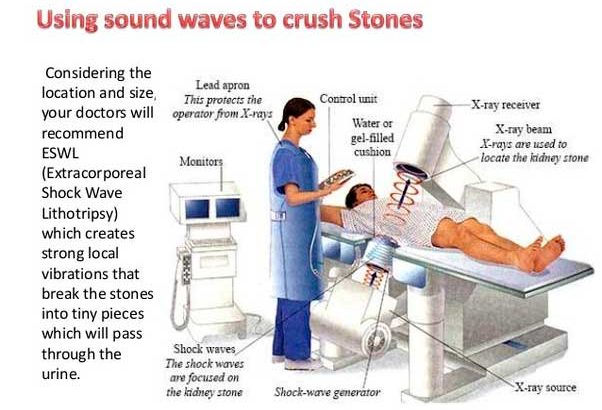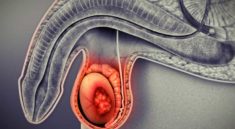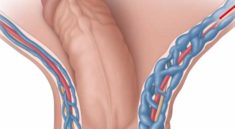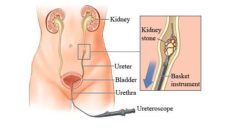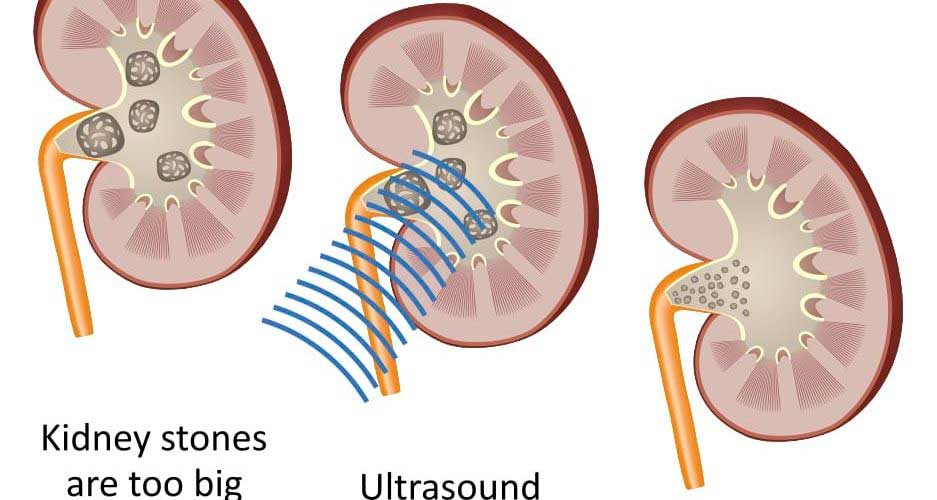

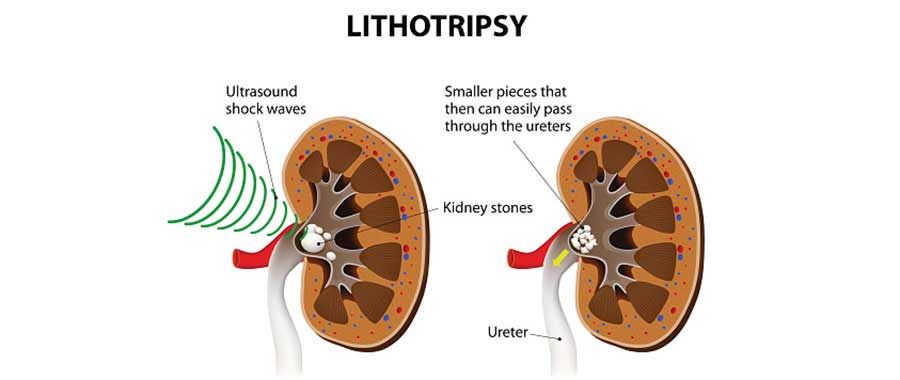
INFORMATION
Lithotripsy is a procedure that uses shock waves to break up stones in the kidney, bladder, or ureter (tube that carries urine from your kidneys to your bladder). After the procedure, the tiny pieces of stones pass out of your body in your urine.
Description
Extracorporeal shock wave lithotripsy (ESWL) is the most common type of lithotripsy. “Extracorporeal” means outside the body.
To get ready for the procedure, you will put on a hospital gown and lie on an exam table on top of a soft, water-filled cushion. You will not get wet.
You will be given medicine for pain or to help you relax before the procedure starts. You will also be given antibiotics.
When you have the procedure, you may be given general anesthesia for the procedure. You will be asleep and pain-free.
High-energy shock waves, also called sound waves, guided by x-ray or ultrasound, will pass through your body until they hit the kidney stones. If you are awake, you may feel a tapping feeling when this starts. The waves break the stones into tiny pieces.
The lithotripsy procedure should take about 45 minutes to 1 hour.
A tube called a stent may be placed through your back or bladder into your kidney. This tube will drain urine from your kidney until all the small pieces of stone pass out of your body. This may be done before or after your lithotripsy treatment.
Why the Procedure is Performed
Lithotripsy is used to remove kidney stones that are causing:
- Bleeding
- Damage to your kidney
- Pain
- Urinary tract infections
Not all kidney stones can be removed using lithotripsy. The stone may also be removed with:
- Atube (endoscope) inserted into the kidney through a small surgical cut.
- A small lighted tube (ureteroscope) inserted through the bladder into ureters. Ureters are the tubes that connect the kidneys to the bladder.
- Open surgery (rarely needed).
Risks
Lithotripsy is safe most of the time. Talk to your doctor about possible complications such as:
- Bleeding around your kidney, which may require you to get a blood transfusion
- Kidney infection
- Pieces of the stone block urine flow from your kidney (this may cause severe pain or damage to your kidney)
- Pieces of stone are left in your body (you may need more treatments)
- Ulcers in your stomach or small intestine
- Problems with kidney function after the procedure
Before the Procedure
Always tell your health care provider:
- If you are or could be pregnant
- What drugs you are taking, even drugs, supplements, or herbs you bought without a prescription
During the days before the surgery:
- You will be asked to stop taking blood thinners such as aspirin, ibuprofen (Advil, Motrin), warfarin (Coumadin), and any other drugs that make it hard for your blood to clot. Ask your provider when to stop taking them.
- Ask your doctor which drugs you should still take on the day of the surgery.
On the day of your procedure:
- You may not be allowed to drink or eat anything for several hours before the procedure.
- Take the drugs you have been told to take with a small sip of water.
- You will be told when to arrive at the hospital.
After the Procedure
After the procedure, you will stay in the recovery room for up to about 2 hours. Most people are able to go home the day of their procedure. You will be given a urine strainer to catch the bits of stone passed in your urine.
Outlook (Prognosis)
How well you do depend on the number of stones you have, their size, and where in your urinary system they are. Most of the time, lithotripsy removes all the stones.
How long does pain last after lithotripsy?
It is normal to have a small amount of blood in your urine for a few days to a few weeks after this procedure. You may have pain and nausea when the stone pieces pass. This can happen soon after treatment and may last for 4 to 8 weeks.
What size kidney stone requires lithotripsy?
URETEROSCOPIC LITHOTRIPSY FOR LARGE KIDNEY STONES. Percutaneous nephrolithotomy (PNL) is currently the first-line recommended treatment for large kidney stones ≥ 20 mm[7,8]
Is a stent necessary after lithotripsy?
A stent is not necessary for all patients who have SWL. In fact, it is not needed for most patients. Stents can cause blood in the urine, frequent urination, and discomfort, although these symptoms generally improve after a few days. A stent should not be left in place for more than three to six months.
What can I eat after lithotripsy?
Follow these guidelines if you have calcium kidney stones:
- Drink plenty of fluids, particularly water.
- Eat less salt. …
- Have only 2 or 3 servings a day of foods with a lot of calcium, such as milk, cheese, yogurt, oysters, and tofu.
- Eat lemons or oranges or drink fresh lemonade. …
- Limit how much protein you eat.
Is a stent necessary after kidney stone removal?
CONCLUSIONS: Stent omission is associated with an increased risk of unplanned medical visits, despite reduced symptoms compared to stented patients. … A stent is a small, thin tube that can be left in the ureter after the stone is removed to help pass urine and prevent new stones from blocking the tube.

